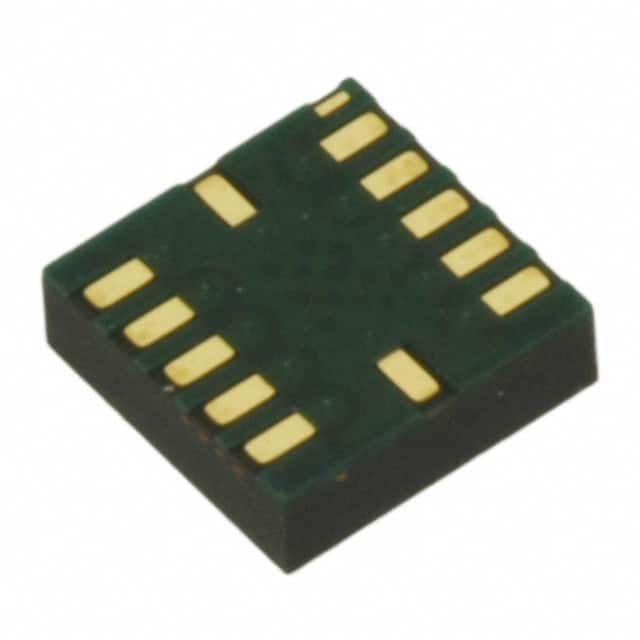BMA180 - Acceleration Sensor
Introduction
The BMA180 is an acceleration sensor belonging to the category of MEMS (Micro-Electro-Mechanical Systems) sensors. It is widely used in various applications that require accurate measurement of acceleration and tilt. This entry provides a comprehensive overview of the BMA180, including its basic information, specifications, pin configuration, functional features, advantages and disadvantages, working principles, application field plans, and alternative models.
Basic Information Overview
- Category: MEMS Acceleration Sensor
- Use: Measurement of acceleration and tilt
- Characteristics: High accuracy, low power consumption, compact size
- Package: LGA (Land Grid Array)
- Essence: Accurate and reliable measurement of acceleration
- Packaging/Quantity: Typically available in tape and reel packaging with varying quantities
Specifications
- Measurement Range: ±1g to ±16g
- Output Resolution: 14-bit digital output
- Operating Voltage: 1.62V to 3.6V
- Interface: I2C or SPI
- Operating Temperature Range: -40°C to +85°C
- Dimensions: Small form factor, typically 3mm x 3mm
Detailed Pin Configuration
The BMA180 features a standard set of pins for power supply, communication interface, and data output. The detailed pin configuration includes: - VDD: Power supply - GND: Ground - SDA/SCL: I2C communication interface - CS/SCK/SDI/SDO: SPI communication interface - INT: Interrupt output - RES: Reset pin
Functional Features
- High Accuracy: Provides precise measurement of acceleration with minimal error
- Low Power Consumption: Suitable for battery-powered devices and applications
- Digital Output: Delivers 14-bit digital data for easy integration with microcontrollers
- Interrupt Function: Allows for efficient event-based triggering based on acceleration thresholds
- Self-Test Feature: Enables self-diagnosis and calibration
Advantages and Disadvantages
Advantages
- Accurate and reliable measurement
- Low power consumption
- Compact size for easy integration
- Versatile interface options (I2C and SPI)
- Self-test feature for enhanced reliability
Disadvantages
- Limited measurement range compared to some other sensors
- Higher cost compared to lower-end accelerometers
- Requires careful handling due to its small size
Working Principles
The BMA180 operates based on the principle of capacitive sensing, where changes in capacitance due to acceleration are converted into digital signals. This allows for precise measurement of acceleration along multiple axes, making it suitable for various applications requiring motion detection and orientation sensing.
Detailed Application Field Plans
The BMA180 finds extensive use in diverse application fields, including: - Consumer Electronics: Mobile devices, gaming controllers, wearable gadgets - Automotive: Vehicle stability control, rollover detection, impact sensing - Industrial Automation: Robotics, vibration monitoring, tilt sensing - Health and Fitness: Activity tracking, gesture recognition, posture monitoring
Detailed and Complete Alternative Models
Several alternative models to the BMA180 include: - BMA250: Enhanced version with extended measurement range - BMA280: Improved accuracy and lower noise performance - ADXL345: Competing sensor with similar capabilities - MPU6050: Integrated gyroscope and accelerometer module
In conclusion, the BMA180 acceleration sensor offers high accuracy, low power consumption, and versatile application possibilities across various industries. Its compact size and digital output make it a popular choice for designers seeking reliable motion sensing solutions.
Word Count: 536
רשום 10 שאלות ותשובות נפוצות הקשורות ליישום של BMA180 בפתרונות טכניים
Sure, here are 10 common questions and answers related to the application of BMA180 in technical solutions:
What is the BMA180 accelerometer used for?
- The BMA180 accelerometer is used for measuring acceleration and tilt in various technical applications such as robotics, automotive systems, and industrial equipment.
What is the operating voltage range of the BMA180?
- The operating voltage range of the BMA180 is 1.62V to 3.6V.
How does the BMA180 communicate with a microcontroller?
- The BMA180 communicates with a microcontroller using either SPI (Serial Peripheral Interface) or I2C (Inter-Integrated Circuit) communication protocols.
Can the BMA180 measure both static and dynamic acceleration?
- Yes, the BMA180 can measure both static and dynamic acceleration, making it suitable for applications that require precise motion detection.
What is the resolution of the BMA180 accelerometer?
- The BMA180 has a resolution of 14 bits, providing high precision in measuring acceleration.
Is the BMA180 suitable for battery-powered devices?
- Yes, the BMA180's low power consumption makes it suitable for battery-powered devices, extending the device's operational lifetime.
Does the BMA180 have built-in motion detection features?
- Yes, the BMA180 includes built-in motion detection features, allowing for easy implementation of motion-based functionality in technical solutions.
What is the temperature range in which the BMA180 operates?
- The BMA180 operates within a temperature range of -40°C to +85°C, making it suitable for use in various environmental conditions.
Can the BMA180 be used for vibration monitoring applications?
- Yes, the BMA180 can be used for vibration monitoring applications, providing accurate measurement of vibrations in machinery and equipment.
Are there any specific calibration requirements for the BMA180?
- The BMA180 requires minimal calibration, and its factory calibration provides accurate and reliable measurements for most applications.
These questions and answers cover various aspects of the BMA180 accelerometer and its application in technical solutions.


